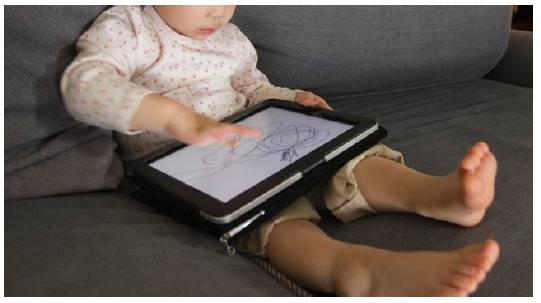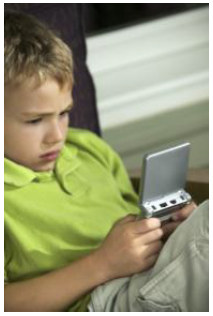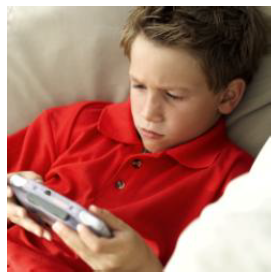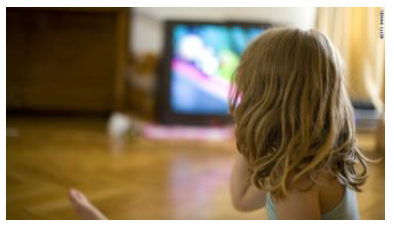Digital Children in the 21st Century
In the 21st century, babies to school-age children are digital consumers, often using TV, computers, gaming systems, even smartphones and tablets. From the time they can grasp an object in their hands, children begin to play with their parents’ smartphones or tablets. One can find more than 40,000 YouTube video uploads about infants or toddlers playing with such devices.
“Our children’s digital lives are turning them into much different creatures from us – and not necessarily for the better.”
– Dalton Conley, Time Magazine
According to a 2011 Common Sense Media Research Study about children’s media use in America, 40 percent of 2- to 4-year-olds use smartphones, iPods, iPads or similar devices1. In another survey conducted in 2011, 90 percent of parents said their children under age 2 watch some form of electronic media2. Although young children today are exposed to screen media as early as 6 months, children back in the 1970s were not exposed to television until the age of 23. However, the most recent study on parents’ attitudes about children’s media use revealed that the majority of U.S. parents are largely unconcerned about their young children’s media use4.

Children’s Media Use and Possible Concerns
Numerous harmful issues have been associated with children’s media use. These include:
Children’s Eye Health
As parents are spending more time using digital media, so are their children, and the children might be suffering from the side effects of overuse, like their parents. This includes digital eye strain (red, dry or irritated eyes; blurred vision; or eye fatigue); back, neck and shoulder pain; and headaches. Excessive exposure to the use of smartphones at an early age can also trigger poor eyesight for kids5.

Brain Development
Our brains are designed to be effective when a socially interactive environment stimulates curiosity and exploration. Because it is possible that excessive childhood involvement with digital media limits children’s social interaction, this could hinder children’s brain development and have negative effects on their overall development6.
Sleep Problems
Studies have started showing an association of media use with sleep problems in preschool-aged children. The studies revealed that the length and timing (daytime versus evening) of screen time (television, DVDs/videos, computers, video games and hand-held devices) and the content of media (violent versus nonviolent) affected the amount of the increase in sleep problems7,8

Attention Problems
Research suggests that the use of digital media might have an effect on children’s attention skills, such as increasing hyperactivity and difficulty in concentrating9,10.
Late Academic Achievement
Studies suggest that excessive media use (computers or video games) at an earlier age are associated with lower academic achievement later in life11,12.
Social Development
Children who spend more time with media devices reportedly have lower levels of personal contentment and have a tendency to get in trouble more often. They also report feeling more sad or bored than their counterparts7.
Physical Development and Obesity
Digital media use might take time away from play and physical activities. It has been reported that a child who spends more than four hours a day watching television is more likely to be overweight than one who watches less than two hours13. Children’s excessive use of digital media might limit necessary physical challenges to their bodies in order to achieve optimal sensory and motor development.

Language Development
Studies have shown that the use of digital media could delay children’s language development, especially for children age 2 and under2,14.
A Possible Benefit
Although scarce, a few studies have found that high-quality educational programs with a specific goal to teach academic skills can have benefits for children older than 2 years, but not for children younger than 2 years15.

American Academy of Pediatrics Media Use Recommendations
The American Academy of Pediatrics has developed many recommendations, based on research, related to child health and development in a variety of areas, including Sudden Infant Death Syndrome, Attention Deficit Hyperactivity Disorder and media use. In 2011, the Academy issued their most recent policy statement featuring recommendations regarding media use by children under age 216. These recommendations for children under age 2 suggests that parents and caregivers:
- Set media limits for their children under age 2. The Academy encourages ZERO media use for this age group. Parents should have a strategy for managing electronic media if they choose to allow their children to use digital media at this age.
- Instead of digital media use, plan supervised independent play (playing with blocks, coloring on blank paper or running around the playground) for infants and young children during times that a parent cannot sit down and actively engage in play with the child.
- Do not put a television set in the child’s bedroom.
- Recognize that adults’ media use can have a negative effect on children.

What Parents/Caregivers Can Do
For some parents digital media is used to keep young children occupied so they can do chores, prepare a meal or get ready for work. For other parents, digital media serves educational purposes. Parents also believe that when children are fussy or acting out, digital media can calm them. Lastly, some parents use digital media as rewards and incentives for good behavior. How can parents use digital media for the most benefits? Many of the recent studies have shown that media is very much a part of all of our lives these days, and so it is important that parents/caregivers understand how to use it in healthy ways.
1. Have clear rules and expectations about media usage
If your children are 0 to 2 years, of course it is better not to allow them to use any digital media. Older children (3 to 6 years) should have less than one hour of screen time per day. If parents use those devices less often in front of their children, children may not want to use them. However if they are already exposed to digital devices, it is better to limit how long and when they can use them. Especially avoid night time use.
2. Substitute direct interaction and real-world experience alternatives for media time.
Nothing takes the place of direct interaction and real-world experiences. It is important to take some of the children’s media time and replace it with parent-child interactive activities and real-world experiences, such as art projects, outdoor activities, sports, interactive reading, music and movement, games and so on. Of course, children can draw pictures and match objects using smartphones or iPad applications, but they cannot use all their senses because they cannot see or touch the object. Many producers of new digital media claim their products have educational benefits, but in many cases, they seem to displace hands-on educational activities, such as reading books or playing board games.

3. Do not allow children to own digital devices.
When children own these digital media devices, more often they will use them. Until children are at least in their teen years, do not let them own their own devices such as an iPad, smartphone, TV, computer, Baby Einstein or Leap Frog.

4. Choose positive quality programs/apps for preschoolers and older children.
During media use, try to find apps that teach and expand your child’s growing brain. Parents need to spend time identifying these. There are a few online websites recommending quality educational materials, visit kidsfirst, kindertown or commonsensemedia for more information.
5. Co-view and enhance parent-child interaction during digital media use.
Experts say that educational media programs were developed to be watched by both the parent and the child to facilitate social interactions and the learning process, but many parents have used digital media devices as a digital nanny. Parent co-viewing and interaction with children during digital media use is most likely to have a positive effect on learning from educational media.
6. Limit background media exposure.
Parents often think that children may not watch or hear a TV. However, background media exposure can have potentially negative effects on children’s development and parent-child interactions17. Background media can disrupt children’s play behavior even when they are not paying attention to it.

7. Limit your media use.
Children whose parents limit their media use spend less time with digital media than their peers. It is important that parents have good habits themselves.
1 Federal Trade Commission
2 Zimmerman, F. J, Christakis, D. A., Meltzoff, A. N. (2007). Television and DVD/video viewing in children younger than 2 years. Archives Pediatr Adolesc Med. 2007;161(5):473– 479
3 DeLoache, J. S., & Chiong, C. (2009). Babies and baby media. American Behavioral Scientists, 52, 115.
4 Center on Media and Human Development (2013). Parenting in the age of digital technology: A national survey. Northwestern University.
5 The Vision Council
6 Lillard, A. S., & Peterson, J. (2011). The immediate impact of different types of television on young children’s executive function. Pediatrics, 128(4), 1-6.
7 Garrison, M. M., Liekweg, K., Christakis, D. A. (2011). Media use and child sleep: the impact of content, timing, and environment. Journal of the American Academy of Pedatrics, pediatrics.aappublications
8 Garrison, M. M., & Christakis, D. A. (2012). The impact of healthy media use intervention on sleep in preschool children. Pediatrics, 130 (3), 492-499.
9 Christakis, D. A., et al. (2004). Early television exposure and subsequent attention problems in children. Pediatrics, 113, 708-713.
10 Friedrich, L. K., & Stein, A. H. (1973). Aggressive and prosocial television programs and the natural behavior of preschool children. Monographs of the Society for Research in Child Development, 38, 4.
11 Pagani, L. S., Fitzpatrick, C., Barnett, T. A., &Dubow, E. (2010). Prospective associations between early childhood televeision exposure and academic, psychosocial and physical well-being by middle childhood. Archvies of Pediatrics and Adolescent Medicine, 164(5), 425-431.
12 Hofferth, S. L. (2010). Home media and children's achievement and behavior. Child Development, 81 (5), 1598-1619
13 Kids Health
14 Sims, C. E., & Colunga, E. (In Press). Lanuage Development in the Age of Baby Media: What We Know and What Needs to be Done.
15 Kirkorian, H. L., Wartella, E. A., & Anderson, D. R. (2008). Media and young children’s learning. The Future of Children, 18(1), 39-61.
16 Council on Communications and Media (2011). Policy statement: Media use by children younger than 2 years. Pediatrics, 128(5), 1-6.
17 Division of Developmental and Behavioral Pediatrics


